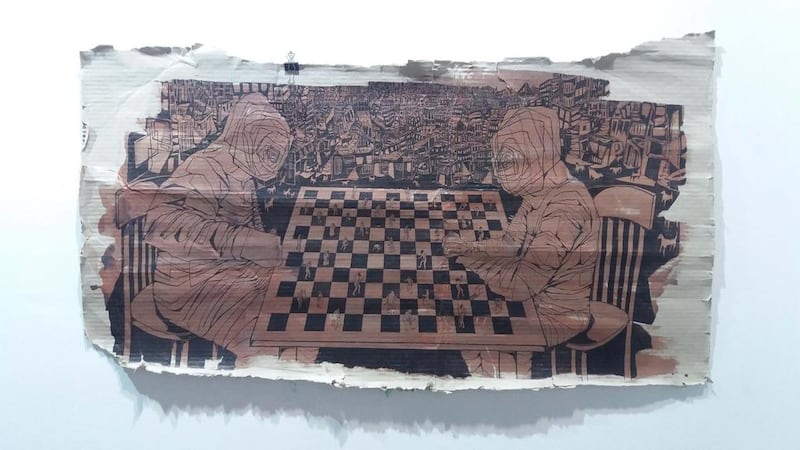Two figures face each other across a chess board dotted with tiny pieces, seemingly pitting cowering humans against powerful ancient Egyptian gods.
An array of colourfully dressed figures sit around a golden table, in a tableau reminiscent of Leonardo da Vinci's The Last Supper. On their plates are severed human hands.
These disturbing yet riveting scenes were among the highlights of the seventh Beirut Art Fair. Thirteen ink-and-acrylic works on cardboard by Egyptian artist Ali Abdel Mohsen, part of a series entitled True Stories, greeted visitors at Revealing, an exhibition of contemporary work sponsored by Société Générale de Banque au Liban.
The 27 participating galleries were asked to choose one pioneering artist from their roster, resulting in a varied selection of artists, some of them just beginning their careers, others with a well-established international presence.
Mohsen, who is represented by Cairo’s Mashrabia Gallery of Contemporary Art, is a newcomer to the regional art scene. His colourful mixed-media works are executed on irregular panels made from old cardboard boxes scavenged from the streets of Cairo. Each piece is inspired by Egypt’s capital city, and seeks to convey a narrative through roughly scrawled figures, their heads replaced by swirling lines that resemble simplified thumbprints, the universal currency of the police state.
In New World Again, boats filled with anonymous refugees float beside a ramshackle city. In Resurrection Systems, a crowd attends a public hanging, presided over by a figure with the head of a jackal, recalling Anubis, the ancient Egyptian god of the afterlife. His presence, Mohsen explains, signifies that nothing has really changed.
“It’s all about power, and either being manipulated by the powers that be, or among ourselves to try to grasp whatever power we can,” Mohsen says of his work. “Especially with recent events in Cairo, and the confusion and the insecurity that everyone’s feeling, you can’t really get away from that vibe.”
The artist completed the 13 works in the space of just two- and-a-half months, working feverishly in a darkened room, with CNN playing constantly in the background.
“Someone was asking about why everything looks so primitive and basic, and I’m very much into cave paintings – primitive art forms,” Mohsen says. “I don’t feel like we’ve actually progressed that much since then. The constant power struggles … the violence behind everything – I feel like the primitive style of drawing kind of brings that out, links it to what people assume were more brutal or crueller times, but that probably weren’t much crueller than what we’re living in.”
Mohsen's work, fuelled by anger and fear for the future, has a raw energy that draws the eye and excites the imagination. In the context of Revealing, which sets out to promote new talent, his work held its own amid more established artists.
Another highlight was the diminutive works by Polish artist Paulina Surys, who is represented by the ifa gallery in Brussels. Surys’s eerie, gothic work consists of black-and-white analogue photographs, over-painted and manipulated using 3-D elements that transform and deform the original composition. One particularly striking work captured a seated figure wrapped in a sheet of black cloth, like a shroud. Where her face should be, a pyramidal piece of black wood protrudes from the surface of the photo.
Other pieces on show were more traditional. Palestinian artist Rafat Asad, represented by Gallery One, chose to exhibit a series of haunting landscape paintings, capturing the fertile fields and mountains of Palestine with an almost luminous delicacy.
Lebanese artist Christine Kettaneh, represented by Galerie Janine Rubeiz, showed an installation inspired by the death of her father, which prompted her to create letters out of sugar and lay them out as food for the ants in the garden he had loved.
Revealing wasn't entirely successful as a cohesive exhibition, however. The sheer volume and variety of work was overwhelming within the allotted space, making it hard to absorb the individual work. The interesting pieces risked getting lost among the more banal work on show.
Overall, however, the exhibition served as an interesting, if limited, sample of the work being produced by young contemporary artists, yielding several names to look out for in the future.
artslife@thenational.ae





